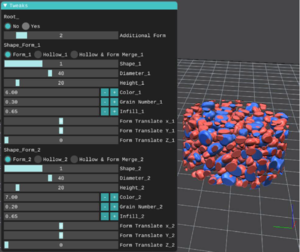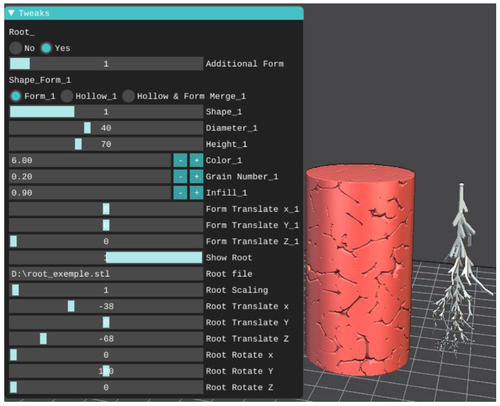
Three-dimensional (3D) printing in soil science is relatively rare but offers promising directions for research. Having 3D-printed soil samples will help academics and researchers conduct experiments in a reproducible and participatory research network and gain a better understanding of the studied soil parameters. One of the most important challenges in utilizing 3D printing techniques for soil modeling is the manufacturing of a soil structure. Until now, the most widespread method for printing porous soil structures is based on scanning a real sample via X-ray tomography. The aim of this paper is to design a porous soil structure based on mathematical models rather than on samples themselves. This can allow soil scientists to design and parameterize their samples according to their desired experiments. An open-source toolchain is developed using a Lua script, in the IceSL slicer, with graphical user interface to enable researchers to create and configure their digital soil models, called monoliths, without using meshing algorithms or STL files which reduce the resolution of the model. Examples of monoliths are 3D-printed in polylactic acid using fused filament fabrication technology with a layer thickness of 0.20, 0.12, and 0.08 mm. The images generated from the digital model slicing are analyzed using open-source ImageJ software to obtain information about internal geometrical shape, porosity, tortuosity, grain size distribution, and hydraulic conductivities. The results show that the developed script enables designing reproducible numerical models that imitate soil structures with defined pore and grain sizes in a range between coarse sand (from 1 mm diameter) to fine gravel (up to 12 mm diameter).
- IceSL: Advanced Modeling and Slicing for 3D Printing. Available online: https://icesl.loria.fr/
- Lua Script https://github.com/RomainBedell/Porous_medium_generator
- ImageJ https://imagej.nih.gov/ij/
Keywords[edit | edit source]
Fused filament fabrication, Open source 3D printing, open source, RepRap, 3D printing; additive manufacturing; soil structure; modeling; slicing; open-source image processing software
See also[edit | edit source]
In the Media[edit | edit source]
- Open source gets dirty with 3D printing Opensource.com 9.4k
- L'open source se salit avec l'impression 3D Maniac Geek





